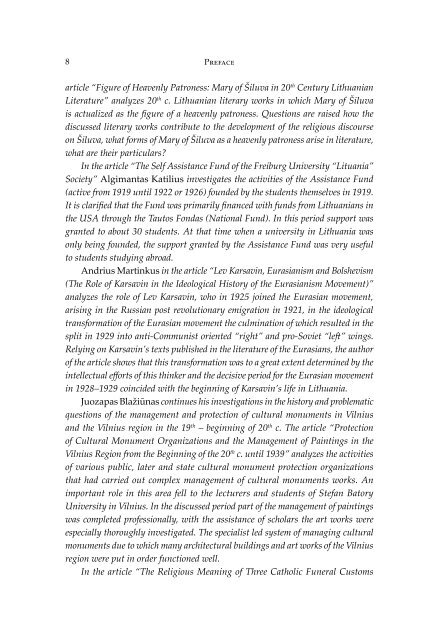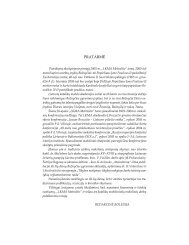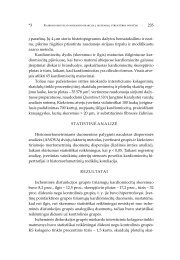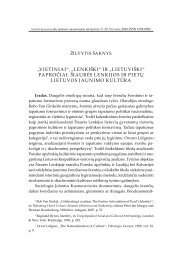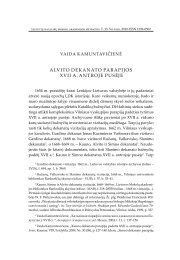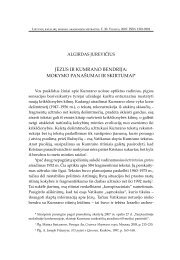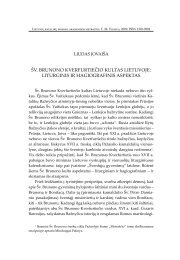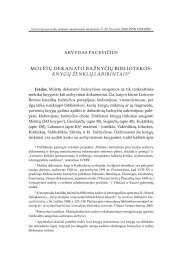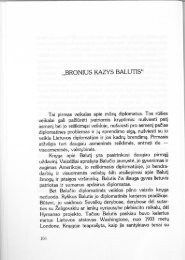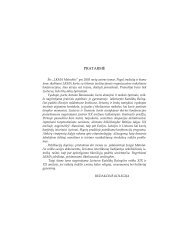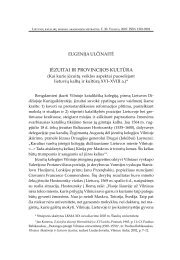Atsisiųsti visą tomą kaip pdf - Lietuvių katalikų mokslo akademija
Atsisiųsti visą tomą kaip pdf - Lietuvių katalikų mokslo akademija
Atsisiųsti visą tomą kaip pdf - Lietuvių katalikų mokslo akademija
You also want an ePaper? Increase the reach of your titles
YUMPU automatically turns print PDFs into web optimized ePapers that Google loves.
8 Preface<br />
article “Figure of Heavenly Patroness: Mary of Šiluva in 20 th Century Lithuanian<br />
Literature” analyzes 20 th c. Lithuanian literary works in which Mary of Šiluva<br />
is actualized as the figure of a heavenly patroness. Questions are raised how the<br />
discussed literary works contribute to the development of the religious discourse<br />
on Šiluva, what forms of Mary of Šiluva as a heavenly patroness arise in literature,<br />
what are their particulars?<br />
In the article “The Self Assistance Fund of the Freiburg University “Lituania”<br />
Society” algimantas katilius investigates the activities of the Assistance Fund<br />
(active from 1919 until 1922 or 1926) founded by the students themselves in 1919.<br />
It is clarified that the Fund was primarily financed with funds from Lithuanians in<br />
the USA through the Tautos Fondas (National Fund). In this period support was<br />
granted to about 30 students. At that time when a university in Lithuania was<br />
only being founded, the support granted by the Assistance Fund was very useful<br />
to students studying abroad.<br />
andrius martinkus in the article “Lev Karsavin, Eurasianism and Bolshevism<br />
(The Role of Karsavin in the Ideological History of the Eurasianism Movement)”<br />
analyzes the role of Lev Karsavin, who in 1925 joined the Eurasian movement,<br />
arising in the Russian post revolutionary emigration in 1921, in the ideological<br />
transformation of the Eurasian movement the culmination of which resulted in the<br />
split in 1929 into anti-Communist oriented “right” and pro-Soviet “left” wings.<br />
Relying on Karsavin’s texts published in the literature of the Eurasians, the author<br />
of the article shows that this transformation was to a great extent determined by the<br />
intellectual efforts of this thinker and the decisive period for the Eurasian movement<br />
in 1928–1929 coincided with the beginning of Karsavin’s life in Lithuania.<br />
juozapas Blažiūnas continues his investigations in the history and problematic<br />
questions of the management and protection of cultural monuments in Vilnius<br />
and the Vilnius region in the 19 th – beginning of 20 th c. The article “Protection<br />
of Cultural Monument Organizations and the Management of Paintings in the<br />
Vilnius Region from the Beginning of the 20 th c. until 1939” analyzes the activities<br />
of various public, later and state cultural monument protection organizations<br />
that had carried out complex management of cultural monuments works. An<br />
important role in this area fell to the lecturers and students of Stefan Batory<br />
University in Vilnius. In the discussed period part of the management of paintings<br />
was completed professionally, with the assistance of scholars the art works were<br />
especially thoroughly investigated. The specialist led system of managing cultural<br />
monuments due to which many architectural buildings and art works of the Vilnius<br />
region were put in order functioned well.<br />
In the article “The Religious Meaning of Three Catholic Funeral Customs


